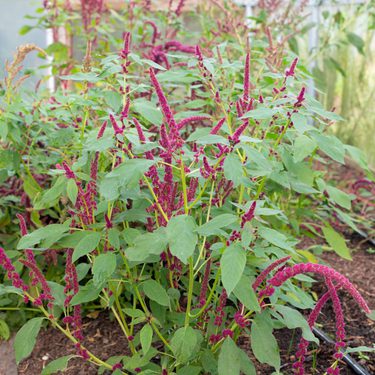
Amaranth, callaloo, bayam, chauli
- Tags
- Vegetables and herbs
| Growing calendar | |
|---|---|
| Sow indoors | Mid Apr - mid May |
| Plant out | Mid May - mid Jun |
| Sow outdoors | June |
| Harvest | Jul - Oct |
About amaranth
Everybody has a different name for amaranth! These include callaloo, doogi, bayam, chaulai, arowo jeja, vlieta, cararu and noteshak (green or pale forms) or laal shak (red leafed) dependent on leaf colour.
In many places, especially on small-scale farms, it's a very useful crop as it has protein rich leaves and seeds, and needs little care in cultivation. In other parts, particularly under intensive agriculture, it is classed as a weed.
Amaranth has a different photosynthesis pathway (it’s a C4 plant) to many other plants so uses sunlight more efficiently, and once established is quite drought tolerant.
The seed does not contain gluten so is suitable for people with coeliac disease, but needs to be processed before eating due to a high saponin content.
How to grow amaranth from seed
Most amaranths grown in the UK do well outside, although some large leafed Jamaican types should be grown under cool greenhouse or polytunnel protection throughout its life.
If starting off indoors, sow in modules at 15-22°C/60-70°F. Germination is quick, within 7-10 days, but plants grow slowly until mid to late April (due to low light levels in the UK) so there isn’t much gained from sowing earlier. Plant out modules from May onwards, without potting up as plants dislike disturbance.
If sowing directly outside, wait until the soil temperature is 15°C/60F or over (this tends to be about mid-June in the UK). Amaranth does best in slightly acid soils (above pH6-7), which is not particularly fertile.
In warm damp conditions, growth is rapid and the first leaves can be picked only weeks after sowing. If flowerheads are removed the plant will continue to produce leaves for several weeks, but repeat sowing monthly until August is recommended to ensure continuity of supply. The plants are not hardy and will die once temperatures drop below freezing.
How to harvest amaranth leaves
Amaranth can be harvested by cutting at six inches above the base. It will regenerate very quickly by producing lots of branches. Young tender stems are edible, but older thicker ones might need to removed unless you are going to cook them for a long time.
The fresh leaves wilt quickly after being cut so should be harvested only as required. They can be cooked in any way spinach can. A West African recipe is to fry the leaves with chopped onion, tomatoes, chillies and any other green vegetables, then add water and simmer until tender. Shortly before serving add ground peanuts or dried shrimp powder to make a thick tasty gravy.
Cooked callaloo also freezes well, like spinach.
Tips on growing amaranth
Once established, plants are quite drought-tolerant. Amaranth isn’t often attacked by pests or diseases but is occasionally affected by aphids and fungal leafspots.
How to save amaranth seeds
Plants produce protein-rich seeds, but these need to be processed before use to remove toxic saponins if required for eating.
Amaranth seeds are tiny, and drop almost immediately on ripening, so harvesting will always be a bit hit and miss. Although capable of crossing with other amaranth varieties, most seem to come fairly true in practice, but if you want to be sure of keeping a variety only grow one type a year.
The best time to harvest is on a dry day, not long after about 10am, when the dew has dried and before the seed has dropped for that day. Some types are unpleasantly spiny so it's best to use gloves.
Cut off the fruiting spikes and place them in a single layer on trays lined with newspaper. Allow the trays to dry in a mouse-free shed or garage for about 10 days.
When the seedheads are dry, shake or stamp on the seedheads to release the seeds and chaff. The seed will fall to the bottom of the trays and can be collected by folding the newspaper and pouring the resultant mixture into a shallow bowl, large envelope or a big paper bag.
Winnowing the seed (by gently transferring it from one shallow bowl to another outdoors) on a day with a light breeze will blow away most of the chaff. If the bowl is gently shaken from side-to-side the chaff will rise to the surface so can be picked off and discarded, leaving virtually pure seed.
If you haven’t managed to save any seed, there is a chance that the plant will have dropped sufficient seeds to pop up again outside for the next few summers. Amaranth seed will store well and remains viable for at least five years.
If you're harvesting amaranth grain for eating, put the seeds in the middle of a clean tea towel or cotton cloth and place this in a sieve. Fold the cloth edges over, so seeds won’t fall out. Put under a running tap until the water coming through stops looking frothy, then shake sieve to remove surplus water and cook as required.
| Growing notes | |
|---|---|
| Difficulty | Easy |
| Germination time | 7-21 days depending on temperature |
| Average time to harvest | As soon as plants large enough – 5 weeks in midsummer |
| Equipment needed | No |
| Average plant size | Varies from 30cm-1m tall, 20cm-60cm across |
| Family group | Spinach |
| Key nutritional content | Vitamin C, protein: seeds are gluten free |
| Latin name | Amaranthus spp. |
